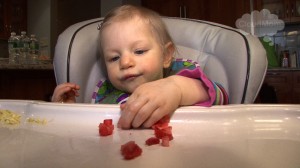Solid Food Basics: Feeding Baby Solids Stage 2 and 3
 Once your baby has gotten the hang of eating solids and is ready to graduate from the so-called “first foods,” you can really start to have fun mixing different food groups and preparing really nutritious and delicious meals.
Once your baby has gotten the hang of eating solids and is ready to graduate from the so-called “first foods,” you can really start to have fun mixing different food groups and preparing really nutritious and delicious meals.
The timeframe for moving on to stage 2 foods depends somewhat on when you began stage 1 and this is definitely something to discuss with your doctor. Some people start their babies on solids at 4 months, so for them stage two may fall between months 6 to 8. Others start later, like I did, at 6 months. Those babies might not be ready for stage two until closer to 8 or 9 months.
Once it is clear your baby has tried a variety of single foods and has had no adverse or allergic reactions, you can begin to mix many of these single foods into medleys and interesting combinations. The basic difference between stage 1 and stage 2 foods is that now the foods can be strained instead of just pureed so the foods are not as soupy and have a bit more texture.
If you opt to buy pre-made baby foods there are a ton of options out there now. Baby food companies are mixing tastes and mixing fruits and veggies in creative and fascinating ways. Some of the traditional brands include Gerber and Beechnut, but also check out purees from companies such as Happy Baby and Plum Organics. These are a lot of fun and are great for travel; you can use some and give the rest later in the day.
Foods to Avoid in the First Year
- Fish
- Eggs
- Nuts
- Cow’s milk
- Honey
My doctor told me to stay away from fish, eggs, and nuts until after the first year because these foods can cause allergic reactions, and honey because it can be a source of bacteria. However, some doctors think it is okay to introduce eggs and certain types of fish beginning at 4-6 months.
Although the American Academy of Pediatrics recommends no cow’s milk until 1 year of age, they do say you can give your child yogurt at this stage for the simple reason that it is easy to digest, where cow’s milk is not. I bought plain yogurt and mixed it up with mashed banana.
Stage 2 Food Combinations – All Smooth Medleys:
- apple-pear-sweet potato
- spinach sweet potato with chicken
- pasta-yogurt-peas
- rice-bananas-apples
- oatmeal-peach-plum
If you make your own foods, you can really come up with some fun combinations. Make sure to watch my show where I demonstrate all this including how to prepare your own stage two foods.
Stage Three and Finger Foods
When your baby has been safely eating these medleys for a few months, you can move onto chunkier purees and combos and also finger foods. If you are buying pre-made food, you might find these with veggies, meats and bits of rice or pasta. If you’re making food, I think this is when your world really starts to open up. You can also make your own soups like split pea with carrot, chicken, and other veggies and you can partially puree this. Now, this sounds hard but when you get into the habit you really are just throwing stuff in there and you can eat it yourself! I’m also a fan of organic oatmeal for myself and for my baby.
Between 8-12 months, your child will develop the pincer grasp, or the ability to grasp things with her thumb and forefinger. This is when finger foods become a really important part of your baby’s development. It is a first step toward independence! You can start with good old Cheerios and Puffs.
Make sure to watch my show where I walk through all of this for you.
Finger Food Choices:
Diced, Soft Cooked Vegetables
- Peas
- Squash
- Potatoes
- Green Beans
- Broccoli
Ripe or Softened Diced Fruits
- Mango
- Banana
- Peaches
- Pears
- Berries
Small Cooked Pieces Of Pasta
Tofu Cubes
Cheerios
Try to encourage your baby to eat these finger foods one piece at a time. As time goes on, you can add pieces of scrambled egg, meat like ground meat, or flaky fish such as white fish or salmon (avoid swordfish, too high in mercury). Now, with regard to fish and eggs, there used to be a fear of giving these before 12 months due to allergies: now for some the tide has turned and giving these is sometimes encouraged to prevent allergies. Check with your doctor to get his view.
In any event this is the time to be adventurous. You can even try pancakes in very small pieces or even pizza, just make sure you give foods in tiny little small bits so that there is no risk of choking and make sure the food is nice and soft. Also make sure never to leave your baby unattended while she is eating.
Now a very important word on finger foods and choking:
Top 10 Choking Hazards According to the AAP:
- Hot Dogs
- Nuts And Seeds
- Chunks Of Meat Or Cheese
- Whole Grapes
- Hard Candy
- Popcorn
- Peanut Butter
- Raw Vegetables
- Chewing Gum
These foods can lodge in your baby’s throat. I have given grapes but cut up in very, very tiny little slivers.
Also, contrary to what you might have gotten when you were a kid, my doctor told me that my baby did not need juice. He said small sips of water were fine after six months and even good to get the baby into the habit of drinking water, especially on a hot day. Make sure you never leave your baby unattended when it comes to any of these foods because you don’t want to run the risk that something gets caught in her throat. And of course go over all of this with your doctor. Have fun feeding your baby!

